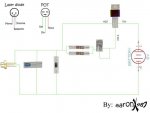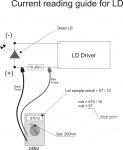Ok i extracted another diode from a scrapped DVD burner. It worked fine til i turned up the pot(i think too much) and now i got a LED.
So i ask, how can the DDL driver be modified so that there is a threshold in power output and if i was to turn the pot to max it will not cause the diode to burn out? What kind of resistor would do the job? I hear people running around 150 - 250mA for the red burners so i want to configure the driver to be able to push out ~275mA at full put turn and the diode should still cope with that.
Any ideas?
Remember im pretty noob at this stuff.
So i ask, how can the DDL driver be modified so that there is a threshold in power output and if i was to turn the pot to max it will not cause the diode to burn out? What kind of resistor would do the job? I hear people running around 150 - 250mA for the red burners so i want to configure the driver to be able to push out ~275mA at full put turn and the diode should still cope with that.
Any ideas?
Remember im pretty noob at this stuff.









